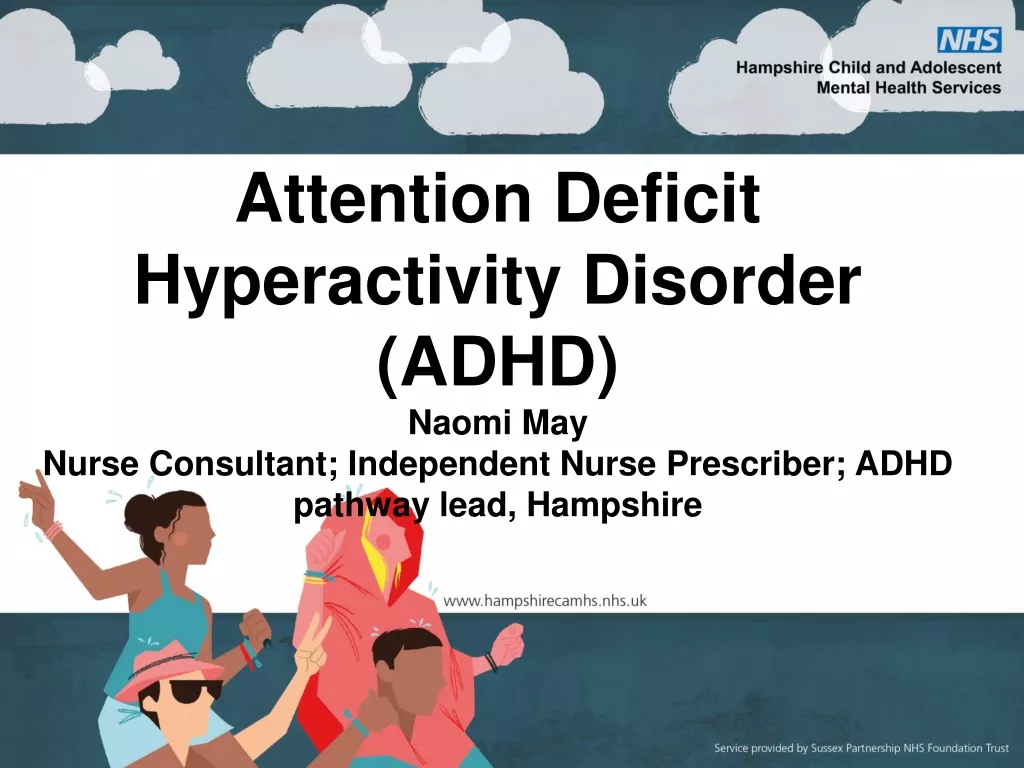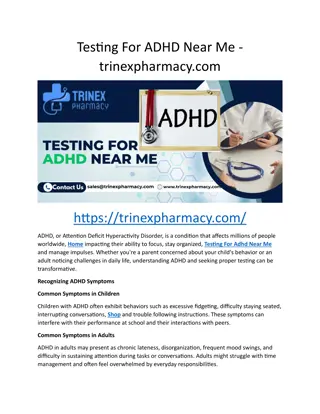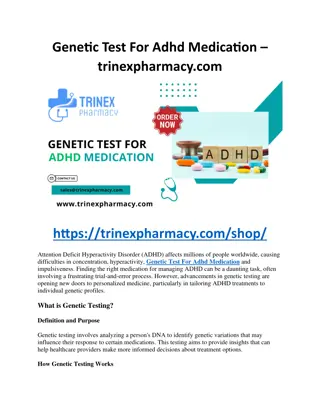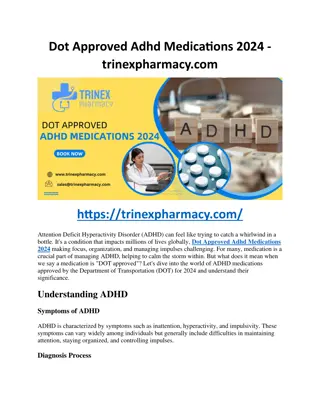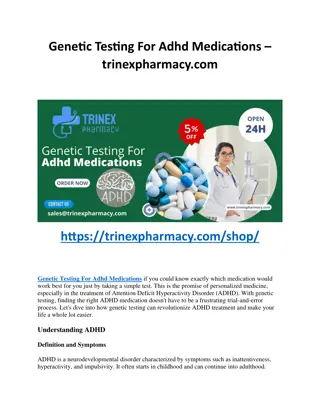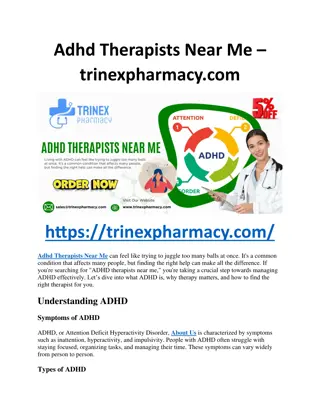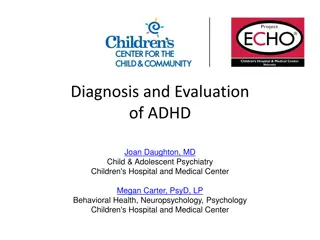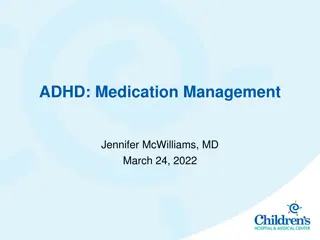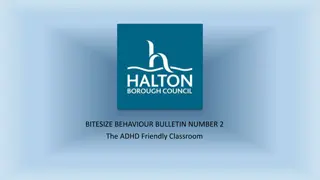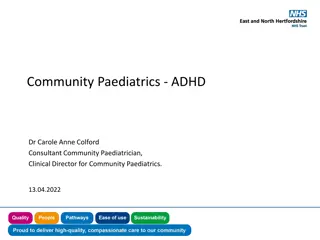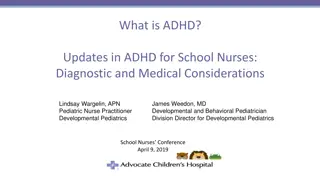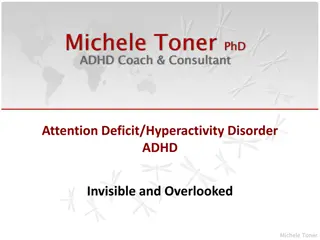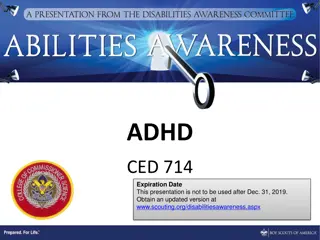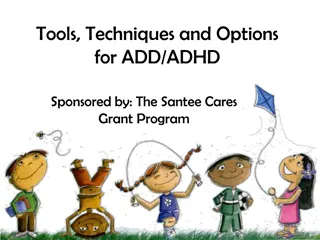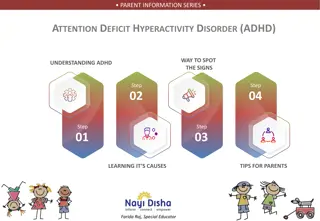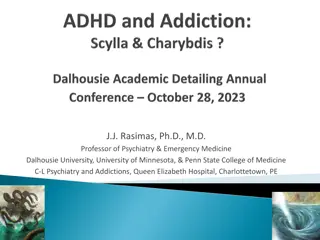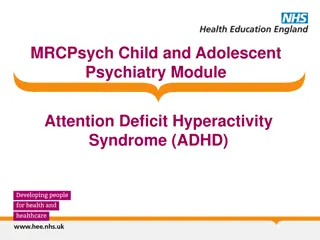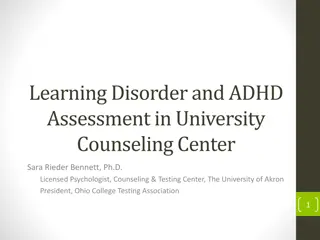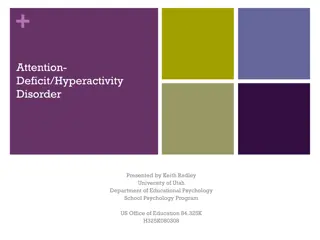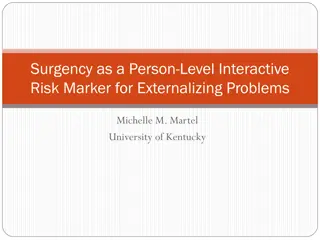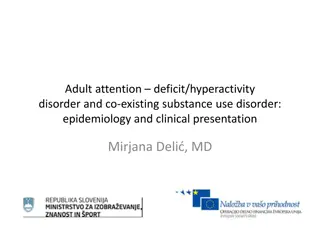Understanding ADHD: Symptoms and Classroom Strategies
This comprehensive guide explores ADHD, its symptoms of inattention and hyperactivity/impulsivity, diagnostic criteria, and classroom strategies for children affected by ADHD. The seminar objectives include defining ADHD, identifying symptoms, evaluating classroom practices, and developing ADHD-aware strategies. Key terms such as comorbid, DSM-V, hyperactivity, impulsivity, and prevalence are explained. ADHD is characterized by persistent patterns of inattention and/or hyperactivity/impulsivity that interfere with functioning and development. Understanding these symptoms and implementing appropriate strategies can significantly impact the lives of individuals with ADHD.
Download Presentation

Please find below an Image/Link to download the presentation.
The content on the website is provided AS IS for your information and personal use only. It may not be sold, licensed, or shared on other websites without obtaining consent from the author. Download presentation by click this link. If you encounter any issues during the download, it is possible that the publisher has removed the file from their server.
E N D
Presentation Transcript
ATTENTION DEFICIT HYPERACTIVITY DISORDER (ADHD) Kelley Keenan The University of Pittsburgh Applied Developmental Psychology
OBJECTIVES Participants of this seminar will be able to: Define what ADHD is and is not Identify the symptoms of ADHD and how they affect students everyday lives and learning Evaluate current classroom practices and how they impact children with ADHD Analyze and develop ADHD cognizant classroom strategies
KEY TERMS ADHD- Attention Deficit Hyperactivity Disorder Comorbid- occurring alongside something else Deficit- lacking or shortage Diagnostic and Statistical Manual, Fifth edition or DSM-V- classification and diagnostic tool for mental disorders Hyperactivity- constant activity Impulsivity- displaying behaviors characterized by little or no forethought Inattention- failure to carefully think about, listen to watch; distraction Prevalence- degree to which something occurs
WHAT IS ATTENTION DEFICIT HYPERACTIVITY DISORDER? DSM-V Criteria Persistent patterns of inattention and/or hyperactivity and impulsivity that interferes with functioning and development and are present in multiple settings One of the most common childhood disorders Children must have 6 symptoms from either or both the inattention and hyperactivity-impulsivity criteria Adolescents (17+) or adults must present 5 symptoms Several symptoms must be/have been present prior to 12 years of age, typically for at least 6 months straight
INATTENTION SYMPTOMS Inattention Failure to give close attention to details Trouble sustaining attention Does not follow through on instructions Does not seem to listen Easily distracted Forgetful in daily activities Trouble organizing tasks or activities Avoids task requiring sustained mental effort Loses things necessary for tasks
HYPERACTIVITY AND IMPULSIVITY SYMPTOMS Hyperactivity and Impulsivity Fidgets with or taps hands or feet or squirms in seat Leaves seat during situations when expected to remain in seat Runs or climbs in inappropriate situations Difficulty playing quietly Is on the go or driven by a motor Talks excessively Blurts out answers before questions are completed Has difficulty waiting his/her turn Interrupts or intrudes on others
EPIDEMIOLOGY AND PREVALENCE Average onset is 7 years old Symptoms frequently appear between the ages of 3 and 6 Affects about 4.1% of American adults, age 18+, each year Affects 9.0% of children aged 13-18 Boys are 4 times more likely to be at risk than girls Combined type ADHD (inattentive and hyperactivity-impulsivity) is the most prevalent in all age-groups Frequently comorbid with other mental health disorders
DIAGNOSIS Symptoms usually appear between ages of 3 and 6 Hard to diagnosis because symptoms vary by person Pediatricians often will refer families to a mental health specialist Licensed mental health specialist will gain information through observation about the child s behavior as well as the environment Must see child in multiple settings Can frequently be diagnosed with other conditions such as: Learning disabilities Oppositional defiant disorder Anxiety and depression Bipolar Disorder
WHAT DOES ADHD LOOK LIKE? It is It is not A neurological disorder that impairs regulation of attention regulation of motor activity regulation of impulsivity Chronic condition affecting executive functioning A lack of will power Laziness Lack of intelligence or motivation Inadequate parenting An over diagnosed problem
TREATMENT Treatments focus on reducing the symptoms and improving everyday functioning Stimulant or non-stimulant medication can be used to help manage symptoms Reduce hyperactivity and impulsivity and improve the ability to focus Psychotherapy Behavior therapy aimed to get children or adults to change behaviors Organizing tasks and completing task and recognizing disruptive emotions Education or training Learning skills to help breakdown tasks into more manageable parts
CASE STUDY See handout to read Chad s story
ADHD & SCHOOL Tasks these students find most difficult- sitting still, listening quietly, concentrating- are required for most of the day Children want to learn and behave like their peers Students with ADHD are protected under US laws: Section 504 of the Civil Rights Act IDEA- Individuals with Disabilities in Education ADA- Americans with Disabilities Act
CHALLENGES FOR TEACHERS Children with ADHD often Demand attention by talking out of turn Have trouble following instructions, especially if listed in lists Forget to write down homework assignments or bring completed work to school Lack fine motor skills- handwriting and note-taking may be difficult Have trouble with operations that require multiple steps: math work problems, long division Have problem with managing time for long-term projects Struggle with the division of labor in group projects and may distract the whole group from completing a task
WHAT DO YOU NEED TO KNOW? Children with ADHD want to learn like their counterparts In order to help you and your classroom management remember: Accommodations: What can you do to make learning easier for your students? Instructions: Provide concrete instructions and follow schedules Interventions: How to prevent disruptive behaviors Praise/Positive Attitude: Children with ADHD often have their positive and successful behaviors overlooked
HOW YOU CAN ACCOMMODATE STUDENTS WITH ADHD Work Information Dissemination Atmosphere/Seating Classroom Organization Seat children with ADHD away from windows and doors and near the front Seat children in rows and not groups Create a quiet area for test taking and studying Reduce the number of timed tests Give instructions one at a time and repeat as necessary Use visuals: charts, color coding, pictures Provide the most difficult information earlier in the day Create outlines for students to follow Suggest students use three-ring bingers with dividers and folders Mail important information home Color-code material for students Allow time for students to organize to move classes or go home http://www.helpguide.org/articles/add-adhd/teaching-students-with-adhd-attention-deficit-disorder.htm
TEACHING TECHNIQUES Starting Lessons Ending Lessons During Lessons Use a signal at the start of a lesson List an activity agenda on the board State materials needed for the lesson early Establish eye contact during the most important parts of instructions or information Keep instructions simple Include multiple modalities for learning Use visuals and props Allow for breaks Consider letting students use a fidget toy or hold a stress ball Avoid on-spot questions Summarize key points Have students repeat assignments back to you and put the assignments on the board Be specific about what students will need to take home with them to complete assignments http://www.helpguide.org/articles/add-adhd/teaching-students-with-adhd-attention-deficit-disorder.htm
KEY POINTS ADHD impacts all aspects of a child s life and is characterized by persistent patterns of inattention and/or hyperactivity and impulsivity About 1 in 10 school aged children will meet the diagnostic criteria for ADHD ADHD impacts self-regulation skills and is NOT a result of poor parenting skills, laziness, or lack of intelligence or motivation Can be treated using medication, psychotherapy, or through educational methods but is not curable Clear concise instructions, signals, praise, and reminders are all important for children with ADHD
REFERENCES American Psychiatric Association. (1994). Diagnostic and Statistical Manual of Mental Disorders (5th ed.). Washington, D.C: Author. Center For Disease Control. (2014). Attention-Deficit/Hyperactivity Disorder (ADHD). (NCBDDD Pub No); www.cdc.gov National Institute of Mental Health. (1994, reprinted 1996, revised 2003, reprinted 2006, reprinted 2014) Attention deficit hyperactivity disorder (Publication No. 06-3572); www.nimh.nih.gov Segal, J. & Smith, M. (2015). ADD/ADHD and school. Helpguide.org; www.helpguide.org
CONTACT INFORMATION If you wish to duplicate this material, please contact the author, Kelley Keenan; kek117@pitt.edu


